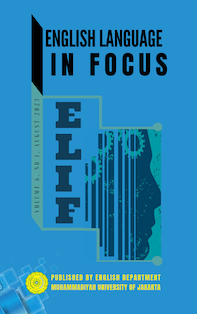Indonesian ELT Students’ Perception Toward British Accent in Speaking Classroom in Tertiary Education
DOI:
https://doi.org/10.24853/elif.6.1.1-8Keywords:
British Accent, Perception, Speaking Classroom, Tertiary EducationAbstract
This study looked into how EFL students’ perception British accents in speaking classroom in tertiary education. It sought to understand how the pupils felt about British accents in speaking classroom. A case study strategy and qualitative methodology are being used in this study. In this study, reflective journals were used to collect data. Several themes were highlighted by the research findings. topics pertaining to students' experiences speaking in British accents in classroom. The results indicated that pupils find the British accent is difficult. Students' pronunciation in speaking and grammatical terms is more challenging when they have a British accent. According to the kids, a British accent is an interesting accent for conversing. Moreover, the British accent and speaking mannerism make English pronunciation more official than it is in the United StatesReferences
Britain, D., & Trudgill, P. (1999). Migration, new‐dialect formation and sociolinguistic refunctionalisation: reallocation as an outcome of dialect contact. Transactions of the Philological Society, 97(2), 245-256.
Dirgeyasa, I. W. (2015). Reviewing the British English (BRE) and American English (AME) Dialects. Language Circle: Journal of Language and Literature, 9(2).
Fraenkel, J. R., Wallen, N. E., & Hyun, H. H. (2012). How to design and evaluate research in education (Vol. 7, p. 429). New York: McGraw-hill.
Gunawan, A., & Aminah, N. (2020). English Students’ Awareness of American and British Variety of English’s Differences. Lingua, 16(1), 36-52.
Herawati, I., & Istinganah, E. L. (2022). Students’ Perception of English as Global Language. Aplinesia (Journal of Applied Linguistics Indonesia), 6(1), 18-25.
Hermini, H. (2019). Students’perception Toward American and British English in Cokroaminoto University. IDEAS: Journal on English Language Teaching and Learning, Linguistics and Literature, 7(1).
Horobin, Simon. (2016). How English Became English. Oxford: Oxford University, Press.
Hughes, A., Trudgill, P., & Watt, D. (2012). English Accents & Dialects (Fifth). Retrieved from http://www.ghbook.ir/index.php?name=فرهن گ و رسانه های نوین&option=com_dbook&task=readonline&book_id=13650&page=73&chkhashk=ED9C9491B4&Itemid=218&lang=fa&tmpl=component
Kachru, B. (2008). World Englishes: Approaches, issues, and resources. Cambridge University Press, 25(1).
McKenzie, Y. A., Bowyer, R. K., Leach, H., Gulia, P., Horobin, J., O'Sullivan, N. A., ... & (IBS Dietetic Guideline Review Group on behalf of Gastroenterology Specialist Group of the British Dietetic Association). (2016). British Dietetic Association systematic review and evidence‐based practice guidelines for the dietary management of irritable bowel syndrome in adults (2016 update). Journal of Human Nutrition and Dietetics, 29(5), 549-575.
Talenta, P. I., & Wibowo, R. A. (2022). The Impacts of British Accents on Students’ Dialects in a Speaking Class. English Language and Education Spectrum, 2(1), 18-23.
Wei, R., & Su, J. (2012). The statistics of English in China: An analysis of the best available data from government sources. English Today, 28(3), 10–14. https://doi.org/10.1017/S026607841200023
Published
Issue
Section
License
Authors who publish with this journal agree to the following terms:
- Authors retain copyright and grant the journal right of first publication with the work simultaneously licensed under a Creative Commons Attribution License that allows others to share the work with an acknowledgment of the work's authorship and initial publication in this journal.
- Authors can enter into separate, additional contractual arrangements for the non-exclusive distribution of the journal's published version of the work (e.g., post it to an institutional repository or publish it in a book), with an acknowledgment of its initial publication in this journal.
- Authors are permitted and encouraged to post their work online (e.g., in institutional repositories or on their website) before and during the submission process, as it can lead to productive exchanges, as well as earlier and greater citation of published work (See The Effect of Open Access).

